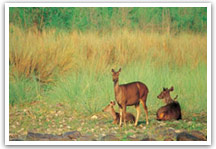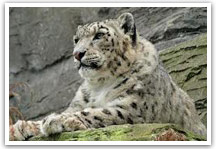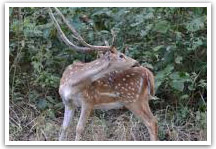



Living in the mountains mostly in places that are not easily accessible the people of the district have been able to preserve their culture, folklore, folksongs and folkdances, the last, a distinctive feature of the district, being seasonal, traditional and religious, some of the better known being described below.....Read More
Nanda Devi National Park
The Nanda Devi National Park is situated near the Nanda Devi, the second highest mountain peak of India. The national park has some of the unique high altitude flora and fauna in the world. The park offers breathtaking sceneries, wooded environment and richness of biosphere. UNESCO has declared the Nanda Devi Biosphere as a World Heritage Site.
Devi National Park is situated near the Nanda Devi, the second highest mountain peak of India. The national park has some of the unique high altitude flora and fauna in the world. The park offers breathtaking sceneries, wooded environment and richness of biosphere. UNESCO has declared the Nanda Devi Biosphere as a World Heritage Site.
W.W. Garden was the first person to access to this region as early as in 1883. But his expedition to the Nanda Devi Peak was not able to create any major impact. In 1936, Tilman and N.E. Odell scaled the Nanda Devi once again and made the way for others to follow. The region became a Game Sanctuary in 1939. The sanctuary was disturbed since 1950's when organized expeditions for Nanda Devi started taking place. The Government of India declared this area as a National Park in 1982. Later it was awarded the special status of a Biosphere Reserve.
Flora and Fauna in Nanda Devi National Park
The main vegetation growth in the forests is of fir, birch, rhododendron and juniper. The conditions are drier in the inner part of the sanctuary. There is almost no vegetation ear the Nanda Devi Glacier. The vegetation changes to alpine from the place called Ramnani and only juniper scrubs dominate the vegetal growth. This type of vegetation gradually give way to grasses, prone mosses and lichens. There are around 312 floral species found in this national park out of which around 17 are considered rare.
 the faunal population of species found over here are Bharal, Brown Bear, Common Langur, Goral, Himalayan Tahr, Himalayan Black Bear, Himalayan Musk Deer, Leopard, Serow and Snow Leopard. The avifaunas found in this national park are the Grosbeaks, Rose Finches, Ruby Throat and Warblers. Approximately 80 animal species have been spotted in this park.
the faunal population of species found over here are Bharal, Brown Bear, Common Langur, Goral, Himalayan Tahr, Himalayan Black Bear, Himalayan Musk Deer, Leopard, Serow and Snow Leopard. The avifaunas found in this national park are the Grosbeaks, Rose Finches, Ruby Throat and Warblers. Approximately 80 animal species have been spotted in this park.
Major Wildlife Attractions - Nanda Devi National Park
Nanda Devi National Park is home of Bharal, Brown Bear, Common Langur, Goral, Himalayan Tahr, Himalayan Black Bear, Himalayan Musk Deer, Leopard, Serow and Snow Leopard. The avifaunas found in this national park are the Grosbeaks, Rose Finches, Ruby Throat and Warblers. Approximately 80 animal species have been spotted in this park.
Best Time to Visit - Nanda Devi National Park
The best time to visit the Nanda Devi National Park is from April to October.
How to Get there
Air: The nearest airport to the Nanda Devi National Park is the Jolly Grant Airport at Dehradun. It is at a distance of 295 km from the national park. There are flights connecting Dehradun with Delhi. .
Rail: The nearest railway station to the Nanda Devi National Park is at Rishikesh, which is at a distance of 276 km.
Road: The metaled roads connect Joshimath to other towns of Uttaranchal like Dehradun, Rishikesh and Haridwar. One has to trek till the national Park from Joshimath.
Travel/Tips
The Nanda Devi National Park experiences cold weather for major part of the year as it is at a very high altitude. For almost six months of the year, the region remains under perpetual snow. The rest of the months experiences pleasant climate. The region receives heavy rainfall from June to August.
The tourists should carry light woolens during summers and heavy woolens during the winters.
There is no provision for accommodation and other tourist facilities in the park area. The tourists will have to stay at Joshimath, where there are several hotels, guesthouses and lodges including those of the Garhwal Mandal Vikas Nigam.
STD/ISD and postal facilities are available at Joshimath. Internet facilities are available either at Dehradun or Haridwar.
The Nanda
 Devi National Park is situated near the Nanda Devi, the second highest mountain peak of India. The national park has some of the unique high altitude flora and fauna in the world. The park offers breathtaking sceneries, wooded environment and richness of biosphere. UNESCO has declared the Nanda Devi Biosphere as a World Heritage Site.
Devi National Park is situated near the Nanda Devi, the second highest mountain peak of India. The national park has some of the unique high altitude flora and fauna in the world. The park offers breathtaking sceneries, wooded environment and richness of biosphere. UNESCO has declared the Nanda Devi Biosphere as a World Heritage Site.
W.W. Garden was the first person to access to this region as early as in 1883. But his expedition to the Nanda Devi Peak was not able to create any major impact. In 1936, Tilman and N.E. Odell scaled the Nanda Devi once again and made the way for others to follow. The region became a Game Sanctuary in 1939. The sanctuary was disturbed since 1950's when organized expeditions for Nanda Devi started taking place. The Government of India declared this area as a National Park in 1982. Later it was awarded the special status of a Biosphere Reserve.
Flora and Fauna in Nanda Devi National Park
The main vegetation growth in the forests is of fir, birch, rhododendron and juniper. The conditions are drier in the inner part of the sanctuary. There is almost no vegetation ear the Nanda Devi Glacier. The vegetation changes to alpine from the place called Ramnani and only juniper scrubs dominate the vegetal growth. This type of vegetation gradually give way to grasses, prone mosses and lichens. There are around 312 floral species found in this national park out of which around 17 are considered rare.
 the faunal population of species found over here are Bharal, Brown Bear, Common Langur, Goral, Himalayan Tahr, Himalayan Black Bear, Himalayan Musk Deer, Leopard, Serow and Snow Leopard. The avifaunas found in this national park are the Grosbeaks, Rose Finches, Ruby Throat and Warblers. Approximately 80 animal species have been spotted in this park.
the faunal population of species found over here are Bharal, Brown Bear, Common Langur, Goral, Himalayan Tahr, Himalayan Black Bear, Himalayan Musk Deer, Leopard, Serow and Snow Leopard. The avifaunas found in this national park are the Grosbeaks, Rose Finches, Ruby Throat and Warblers. Approximately 80 animal species have been spotted in this park.
Major Wildlife Attractions - Nanda Devi National Park
Nanda Devi National Park is home of Bharal, Brown Bear, Common Langur, Goral, Himalayan Tahr, Himalayan Black Bear, Himalayan Musk Deer, Leopard, Serow and Snow Leopard. The avifaunas found in this national park are the Grosbeaks, Rose Finches, Ruby Throat and Warblers. Approximately 80 animal species have been spotted in this park.
Best Time to Visit - Nanda Devi National Park
The best time to visit the Nanda Devi National Park is from April to October.
How to Get there
Air: The nearest airport to the Nanda Devi National Park is the Jolly Grant Airport at Dehradun. It is at a distance of 295 km from the national park. There are flights connecting Dehradun with Delhi. .
Rail: The nearest railway station to the Nanda Devi National Park is at Rishikesh, which is at a distance of 276 km.
Road: The metaled roads connect Joshimath to other towns of Uttaranchal like Dehradun, Rishikesh and Haridwar. One has to trek till the national Park from Joshimath.
Travel/Tips

The Nanda Devi National Park experiences cold weather for major part of the year as it is at a very high altitude. For almost six months of the year, the region remains under perpetual snow. The rest of the months experiences pleasant climate. The region receives heavy rainfall from June to August.
The tourists should carry light woolens during summers and heavy woolens during the winters.
There is no provision for accommodation and other tourist facilities in the park area. The tourists will have to stay at Joshimath, where there are several hotels, guesthouses and lodges including those of the Garhwal Mandal Vikas Nigam.
STD/ISD and postal facilities are available at Joshimath. Internet facilities are available either at Dehradun or Haridwar.
Home | Joshimath | Tourism | Hotels | Culture | Education | Villages | Places Near Joshimath | Photo Gallery | Enquriy | Contact Us
Events | Trkking in Joshimath | Joshimath Classified | Skiing at Auli | Yoaga in Joshimath | Pilgrimage Tours
National Parks Tours | Safari Tours | Bird Watching | Corporate Tours
Cuisine | Fairs & Festivals | Local Products
Events | Trkking in Joshimath | Joshimath Classified | Skiing at Auli | Yoaga in Joshimath | Pilgrimage Tours
National Parks Tours | Safari Tours | Bird Watching | Corporate Tours
Cuisine | Fairs & Festivals | Local Products
Copyright © 2023 - All Rights Reserved : joshimath.in Design by : Joshimath Exploration Team

